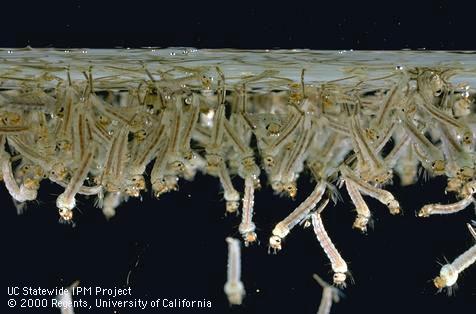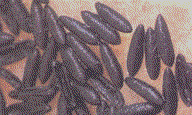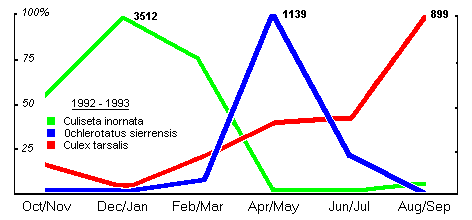|
So do the following: |
| |
• Drain standing water twice weekly
since it’s where mosquitoes lay eggs. This includes checking containers such as
flower pots, tires, gutters, animal
water bowls. ( saltwater marsh mosquitoes can be reduced by creating tidal saltwater daily flooding of otherwise stagnant
pools )
• Use Microbial insecticides Bactimos®, Teknar® or Vectobac®.
• Dusk and dawn are when mosquitoes that carry the
virus are most active so limit outdoor activities at this time or take appropriate precaution.• Dress in long sleeves and
long pants when outdoors especially at dusk and dawn.
• DEET (I use 25%)
is THE ONLY effective
repellant. Effective only for about 4 hours or
less depending on wind, high temperature, high humidity, and sweating. When
applying DEET, thoroughly apply the material to all exposed skin, including
behind the ears.
Special formulations for children contain low
concentrations of DEET in an oil-based medium that slowly releases the
compound and limits its absorption through the skin. Mosquitoes
will bite through lightweight clothing.
( I got bitten thru a teeshirt, worn thin )
• Maintain Screens on doors and windows.
• Contact the
MSMVCD if you
identify major sources of
mosquitoes, so that they can then implement
control measures. Mosquitoes can
migrate several miles from where they develop.
|
 |
 |
 |
| Mosquito Larvae |
Mosquito Rafts |
Saltwater Mosquito Eggs |
| Symptoms: |
|
| |
Most people who become
infected do not become ill. Up to 20% of those infected may develop flu-like symptoms with or without rash. Only about
one in 150 people become severely ill, with symptoms that may include
high fever, severe headache, and stiff neck
may result in meningitis
or encephalitis which can kill.
People who are older than 50 years of age or
have a suppressed immune system have
a higher risk of becoming more severely ill from the virus. In California in 2012, there were 479 reported human cases throughout the
state and 1,644 birds tested positive for the virus. Los Angeles County had
the largest number of human incidents and Sacramento County had the largest
number of infected dead birds. |
SUBMITTING DEAD BIRDS FOR TESTING: |
| |
The State of California and
Marin County health departments are requesting that residents of Marin
County continue to report dead birds to the State hotline. Birds of
particular interest are: crows, ravens, magpies, jays and raptors (hawk or
eagle). The birds must be dead only 24-48
hours to be acceptable for testing. So be sure it wasn't there
the day before.
Contact the California Department of Health Services by
submitting the information via http://www.westnile.ca.gov/report_wnv.php . Because the State is receiving a huge volume of calls,
they are not able to respond in person to all callers.
Dispose of the dead bird, if the dead bird has not been
picked up by five o’clock (5 p.m.) on the day it was reported: Avoid
touching the dead bird with your bare hands. Ensure that your clothing does
not come in contact with the dead bird or any blood, secretions or
feces. Heavy duty, double, plastic bags should be used to pick up the bird,
tightly seal the bags, and dispose in a trash container secure from children
and animals. Afterwards, you should wash your hands thoroughly with warm
water and soap. There is currently no evidence that the virus can be
transmitted to humans that have taken these precautions. |
The
chemicals in the
anti-mosquito pesticides - pyrethroids
| LIFE CYCLE |
|
| |
The life cycles
of mosquitoes vary widely from species to species. Some
female mosquitoes lay single eggs on water surfaces; others lay single eggs
on moist soil where later flooding is likely. Still other species lay
batches of eggs, called rafts, 100
or more at a time on water surfaces. Eggs deposited on water surfaces
usually hatch within a day or so, but eggs laid on soil surfaces do not
hatch until flooding occurs, which may be months or even years later.
Larvae, which are nearly invisible to the naked eye, hatch from eggs. Larvae
molt three times to become 4th-stage larvae. Several days later, this larval
form molts again to become a pupa. Adult mosquitoes emerge from pupae 1 to 2
days after that, with male mosquitoes always emerging first. In summer the
entire life cycle, from egg to adult, may be completed
in a week or less. |
Table 1. Checklist of Possible Mosquito Sources Around the Home.
| Mosquito
Sources |
What to Do
to Reduce Mosquitoes |
| Ponds |
Stock pond with fish, or
use Bacillus thuringiensis subsp. israelensis.
Remove excess vegetation. |
| Swimming pools |
Keep water off cover.
Maintain water quality at all times. |
| Tree holes |
Fill hole with sand or
mortar. |
| Plastic pools |
Drain water when not in
use, or cover so mosquitoes cannot lay eggs. |
| Containers |
Empty water.
Store in an inverted position.
Dispose.
Cover so mosquitoes cannot lay eggs. |
| Bird baths |
Change water at least
once a week. |
| Standing
water |
Eliminate by draining.
Fill in low areas. |
| Watering troughs |
Stock with fish, or
change water weekly. |
| Cooler
drains |
Prevent water from
standing. |
| Street gutter or catch
basins |
Keep litter and garden
debris out of gutter.
Do not overwater yard. |
| Cesspool or septic tanks
|
Seal and cover opening
so mosquitoes can't lay eggs. |
| Roof gutters |
Clean once a year to
remove debris which create pools. |
| Irrigated lawns or
fields |
Avoid overirrigation.
Fix pooling leaks.
Drain standing water. |
|
County
of Marin Department of Health and Human Services:
www.co.marin.ca.us/depts/hh/main/hs/PublicHealth/WNV/WNV.cfm
California Department of Health
Services: www.westnile.ca.gov/
Centers for Disease Control:
www.cdc.gov/ncidod/dvbid/westnile/index.htm
National Pesticide Information
Center (for information on insecticides including DEET):
http://npic.orst.edu
|
the "New Jersey light trap" keeps track of adult mosquitos.
The Marin / Sonoma district keeps 32 New Jersey traps scattered throughout
the two county area. This traps adults of some mosquitoes who are
attracted to light. The trap operates on 110 volt current, with a 40 watt
bulb and a fan that blows attracted insects into a killing jar at the
bottom. A photocell turns the trap on at sunset and off during the day. |
 |
Culiseta inornata
[green] develops huge numbers following the
winter rains;
Ochlerotatus sierrensis [blue], the "treehole mosquito",
is only present in the spring and early summer;
Culex tarsalis [red], the "encephalitis mosquito", occurs year-around, becoming
frequent through the summer and fall. |
 |
|
|

